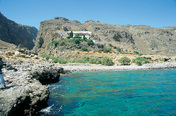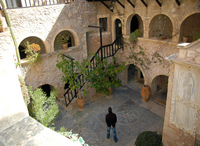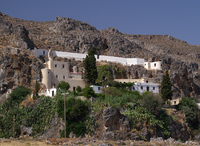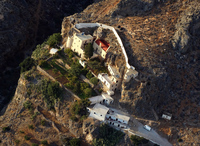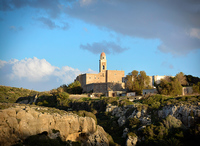The people of Sitia have always been deeply religious and this shows in the 12 monasteries that were built in the region of Sitia. Today only three are working monasteries.
Toplou Monastery
Of these three the most famous is the monastery of "Kira Akrotiriani" or "Toplou" (meaning "with armament" in Greek) because it acquired the right during the Turkish Occupation to keep a cannon. Moni Toplou is a Monastery with a long history which played a significant role in the struggles of the Cretan people for freedom.
In 1654, during the Turkish Occupation, the first bishop of Crete, Neofitos Patellaros, handed over some Cretan monasteries to the Patriach. In 1704 the Monastery of Toplou thus managed to avoid the heavy taxes and land seizures enforced on the Cretan people by the janissaries of the Turkish Occupation..
In 1798, the Patriach of Constantinople, Gregory V, declared the monastery and its surrounding lands to remain "uncultivated and undisturbed" and forbade its sale without the express permission of the Patriach. The monastery is dedicated to Our Lady and to St John.
The monastery is now run by abbot Filotheos Spanoudakis who has presided over the restoration of the monastery and founded a museum of icons and copper engravings. The displays include icons of great artistic worth, bibles, gold-plated silver crosses, patriachal documents, lead seals, vestments etc.
The dining area has recently been adorned by the icon painter Manolis Betinakis using fresco. .
Kapsa Monastery
The Monastery of Kapsa can be found perched on the edge of the mouth of the imposing Pervolaki gorge, overlooking the Libyan Sea. The monastery belongs to Toplou and is 9 kilometres from the village of Makriyialos.
Panagia Faneromeni Monastery
The Monastery of Panagia Faneromeni is situated to the west of Sitia in the area Platani. Nowadays the monastery is virtually abandoned and services are rarely conducted at the small Byzantine church, which probably dates from the 15th century.
Ag. Sofia Monastery
At the valley of Armenoi there is the church of Aghia Sofia, which used to belong to the notable monastery that flourished in older times, bearing the same name. The cave of the "Aghio Pneuma" (Holy Spirit) is also located in the area.






